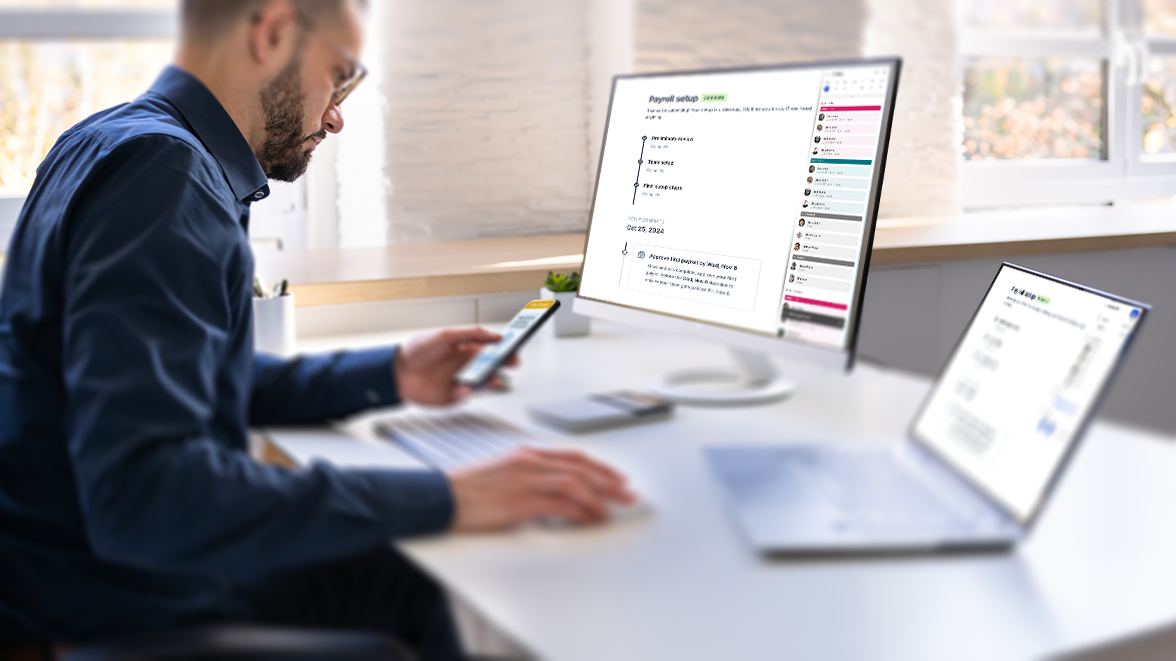
Restaurant Payroll Made Easy: A Complete Guide to Streamline Wages, Tips & Taxes
The restaurant industry has been one of the fastest-growing in the U.S. According to the National Restaurant Association, the industry workforce is projected to grow by 200K jobs, amounting to a total employment of 1.5 million by the end of 2025. With such exponential growth, restaurant payroll management can become challenging for restaurant owners like you. Hence, you must start looking for better technologies and strategies to streamline the process.
In this blog, we will discuss some pain points in the restaurant payroll process and the best practices to overcome them.
How Does Restaurant Payroll Work?
In simple terms, restaurant payroll is the process of compensating employees for their work with wages and benefits. However, it involves various processes and considerations you must keep in mind.
Firstly, you must be aware of the relevant governing bodies and their regulations related to payroll. For instance, any employee who receives a minimum of $30 monthly in tips is considered a tipped employee by the FLSA (a U.S. Department of Labor Act). Secondly, you must know all the relevant forms, such as W-2, to be filled out by you or your employees. Thirdly, you must track employee time and pay them as per federal and state laws. It is also important to consider other factors, like overtime, benefits, bonuses, and minimum wage. Lastly, you must file all the relevant taxes imposed by the IRS and also withhold taxes from employees’ gross pay.
Common Restaurant Payroll Pain Points
Restaurant payroll management can be challenging if not planned properly. Here are some of the major roadblocks.
Diverse Employee Types
Your restaurant comprises employees who are salaried, tipped, or hourly. Therefore, you must apply different payroll rules for each category. Moreover, your payroll process must adhere to guidelines by the Department of Labor.
Tip Management
Managing and distributing tips can be a complex process due to payment delays, miscalculations, and tip pooling errors. However, you must ensure tips are calculated and reported accurately to the IRS to avoid penalties.
Accurate Tax Filing
Payroll taxes involve filing multiple forms, such as W-2, I-9, and 940. Moreover, you must comply with guidelines by regulatory bodies, including Social Security and Medicare (FICA) and Federal (FUTA), and state unemployment taxes (SUTA). Hence, you might find keeping track of filing deadlines and ensuring correct tax calculations a challenge.
Human Errors
If you are still using the traditional spreadsheet-based payroll method, manual errors, such as data entry errors, incorrect wage calculations, and inconsistent time tracking, can be a significant challenge. An efficient restaurant management and POS solution like NOVA automates payroll for an error-free operation.
Compliance Management
Restaurant owners like you must comply with various federal and state laws regarding payroll. For instance, you must adhere to the Fair Labor Standards Act (FLSA) for minimum wage and overtime. Also, the IRS has certain guidelines for tax withholding and reporting. As these laws keep updating regularly, keeping track of all the updates and ensuring compliance can be taxing.
Scheduling and Time Tracking
Most employees in a restaurant, such as servers, work on an hourly basis. Moreover, employees can work overtime or change roles during shifts. Therefore, keeping track of employee scheduling and work hours can be tough, leading to an inefficient payroll process.
How to Manage Payroll in a Restaurant - Best Practices
Doing the Paperwork
One of the primary and critical tasks for any restaurant owner is filing the mandatory paperwork, including federal, state, and local. Some of the essential forms include:
- Form W-4: Used by employees to determine tax withholdings.
- Form W-2: Details the employee’s annual gross pay along with deductions.
- Form I-9: Verifies employee eligibility to work in the U.S.
- Form 940: It is an account for the Federal Unemployment Taxes (FUTA) and is submitted annually.
- Form 941: It is a quarterly report of federal income tax and FICA withholdings.
In addition to these forms, restaurants are also supposed to record and report all tips to the IRS.
Create an Efficient Pay Schedule
Choosing the appropriate payment schedule for your restaurant is critical to balance employee satisfaction and operational efficiency. For instance, the employee might prefer a weekly schedule, but it would be tough to manage. On the other hand, a monthly process, though efficient, may not be liked by employees. Hence, most businesses prefer a bi-weekly payment schedule as it offers the best of both worlds.
You must also ensure that the payment schedule is according to the state laws by the U.S. Department of Labor. For instance, in New Hampshire, restaurant owners can pay employees weekly or bi-weekly only. Whereas in North Carolina, there are no such restrictions.
Account for Multiple Pay Rates
In a restaurant, some employees take up multiple responsibilities. For instance, an employee can work as a server and also fill in as a bartender. However, the hourly rates for these roles can vary. Calculating gross pay with different rates manually can be a task and a half. However, some advanced payroll management solutions can automate payroll based on pay rates.
Managing Tips
Tips management is an essential part of payroll as it determines gross pay calculations, income tax, and tax credit. The IRS mandates that employees report each tip to their employer if the tips earned are over $20 per month. Moreover, restaurants are eligible to avail of the FICA tip credit, which reduces the taxable business income for FICA tax (Social Security and Medicare).
Hence, you must invest in an advanced tip management tool that automates restaurant tip calculations, distribution, and payments. In addition, it helps in tax compliance by generating accurate reports.
Calculating Gross Pay
Gross Pay is the total amount an employee earns before tax and other deductions. Calculating gross pay can be tricky because of diverse pay structures in a restaurant, such as hourly and salaried employees.
For instance, the gross pay of an hourly-paid employee is calculated by multiplying the hourly rate by the number of hours worked. If an employee earns $9 per hour and has worked 40 hours in the payroll cycle, her gross pay would be $360.
However, you also need to factor in multiple variables, like overtime and bonuses. FLSA mandates that restaurants pay a minimum overtime of 1.5 times the regular pay for over 40 work hours a week.
Hence, you must calculate gross pay as per rates, hours worked, and government directives to avoid any conflicts later.
Know the Payroll Taxes
All restaurants must pay payroll taxes to the IRS. Taxes paid by restaurant owners include FUTA (Federal Unemployment Tax Act) and SUTA (Unemployment Tax Act). Currently, the FUTA tax rate is 6.0%. It applies to the first $7,000 you paid to each employee as wages during the year.
Another tax levied by the IRS is FICA (Federal Insurance Contributions Act), which includes social security and medical taxes. The current FICA tax rate for Social Security and Medicare is 6.2% and 1.45%, respectively. Both employers and employees need to pay this tax equally.
Moreover, you must configure tax withholdings to account for the income tax employees need to pay to the IRS.
Adopting Advanced Technology
There is no denying the role of new-age payroll solutions in streamlining the payroll process. The tools automate major payroll processes, including wage calculations, tax deductions, and payments, reducing errors. They also enable restaurants to comply with the IRS, minimizing the risk of penalties. Therefore, opting for the right payroll solution becomes imperative for restaurant owners.
Choosing the Right Restaurant Payroll Software
Here are some parameters you must look for in a restaurant payroll software solution.
- Restaurant-specific features - You must prefer a payroll solution designed specifically for the restaurant industry. Otherwise, you might have to deploy other third-party tools that can overcome its limitations. For instance, you must look for features like tip distributions and pooling workflows.
- Compliance - The platform should help you stay compliant with FLSA, IRS regulations, and state/local wage laws by automating withholdings, overtime rules, and tax forms.
- Ease of Use - The payroll tool must offer a user-friendly interface and navigation. Moreover, you must be able to set up the tool in a few steps with minimal technical expertise.
- Scalability & Cost Structure - Choose a solution that fits your current business size but can also scale with growth. Evaluate pricing tiers, hidden fees, and features in each plan.
- Automated Tax Filing - Select a payroll solution that automates federal and state tax filing. Moreover, the solution must offer all the required forms, such as W-2, 940, etc.
- Integration with Other Tools - Opt for a payroll solution that integrates with other business tools, including the restaurant POS system, ERP, and accounting software.
NOVA- Enhancing Employee Satisfaction
- Quick Onboarding - NOVA enables you to onboard new employees within minutes. The employee information is synced to different business functions simultaneously in real time.
- Easy Tip Management - NOVA automates the tip management process. Tip pools are processed automatically on the basis of operational hours. Moreover, you can distribute tips based on the method of your choice, such as a percentage-based split or point-based sharing.
- Integrated Solution - NOVA offers a comprehensive restaurant management and POS solution. Hence, employee data from POS is synced directly to payroll, eliminating the chances of human errors.
- Deep Insights - NOVA is an AI-native restaurant management solution that offers deep insights and actionable recommendations to manage employee shifts efficiently and reduce labor costs. You can also evaluate employee productivity and the distribution of tips.
- Efficient Work Scheduling - NOVA’s advanced workforce and scheduling tools enable you to track employee time efficiently. You can also manage breaks and overtime for an accurate payroll process.
- Direct-to-bank Payments: Employees get the tips and wages paid directly into their bank accounts, facilitating transparency and faster payments.

Conclusion
There can be various challenges while handling restaurant payroll, including non-compliance with the IRS, improper scheduling, and more. However, if you do the paperwork efficiently, file taxes on time, create a proper scheduling policy, and manage tip distributions optimally, employees get paid fairly and on time. This is possible only if you invest in the right payroll solution for your restaurant.
NOVA offers integrated POS, payroll, and restaurant management features that ensure quick and accurate payroll processing and payments. If you’re looking to simplify your tech stack, streamline your scheduling and payroll, book a free demo of NOVA now.

.jpeg)




